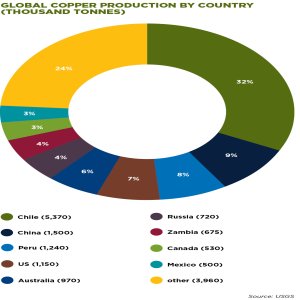Fostering Technology Development in the Mexican Mining Industry

STORY INLINE POST
Q: What are the main technological requirements in the global mining industry and how is Mexico positioned to compete at the international level in this area?
A: Obtaining certain minerals requires more complicated exploration techniques, and mining companies need to use more advanced technology to facilitate the exploration and exploitation of mineral deposits. Given the industry’s need to increase the profitability of mining and metallurgical processes, secondary recovery measures are being applied to larger quantities of minerals that were previously neglected. In order to become more efficient and sustainable, the use of technology is becoming more and more frequent in mining. The industry has been widely defamed in Mexico, as well as in other countries, in this area. This has contributed to more responsible practices to look after employees and the environment. All of the companies that are affiliated with Camimex, which represents 93%, are focused on increasing the use of technology to improve the sustainability and profitability of their operations.
Q: How much of the total investment in the Mexican mining industry in 2012 went towards technology and innovation?
A: It is difficult to define what percentage of investment went specifically to innovation and technology. The level of investment in technology is different for every mine because it depends on the particular characteristics of each one. Large mining companies that are established in Mexico tend to invest at least 15% of their budget in technology. The use of software and other technology during the exploration stage is more common now, as are financial feasibility studies for discovered deposits. For example, with current geometallurgical techniques companies can define the recovery process more effectively. Technology is also applied to minimize safety issues, for example in rock stabilization in underground mining or slops in open pit, and to preserve the environment. Camimex promotes these practices because technological investment pays for itself and offers a very fast ROI.
Q: What are the roles of the government, research centers, universities, and the private sector in innovation and technology development?
A: Conacyt, as the government agency that promotes technological investment, suggests that companies dedicate 1% of their revenues to research and development. Investments made by domestic companies do not meet this figure, except in the automotive and pharmaceutical industries, which traditionally designate a higher percentage of their revenues to this area. Unfortunately, the mining industry is not a priority for Conacyt or the federal government, as the disappearance of the Mining Ministry demonstrates. However, Conacyt wants to see more financing of projects that are linked to research centers, mainly through universities. Camimex is involved in different research activities to provide greater value to certain materials that have already been developed. These efforts have already produced two patents, and some of the companies that are part of Camimex receive Conacyt grants, which have also generated patents. In the last three years Camimex put out a tender for 10 projects and Conacyt backed eight, of which the copper concentrate leaching and bioleaching projects particularly stand out.
Regarding the use of energy, Camimex’s Energy Commission and Innovation and Technology Commission promotes sustainable energy use and production among its members. For example, Peñoles has an 80MW wind farm, Grupo Mexico is constructing one of 75MW, and Minera Autlán has a mini-hydro power plant. Minera Mexico just finished the first stage of a 500MW state of the art combined cycle power plant in Sonora. It is expected that the first 250MW will start being supplied to the Buenavista del Cobre and Nacozari mines this year. This is a good start, but it is definitely not enough. This year Buenavista del Cobre produced 200,000 tonnes of copper, and it is predicted that by 2016 it will be producing 500,000 tonnes annually. With this expansion, the 500MW generated by the combined cycle plant will not meet the demand on the mine. For example, we are contemplating substituting diesel or fuel with solar energy for the heating of fluids. Regarding more efficient water usage, Conagua has made important progress in optimizing the reuse of water in mines, and by building water treatment plants in towns close to mines such as those in San Luis Potosi, Torreon, and Guanajuato, to treat the municipality’s water for use in mining processes.
Q: Most technology is imported into Mexico. What are the main barriers for developing technology locally, and what is Camimex’s strategy for developing domestic technological knowledge?
A: There is a lack of specialized human talent in mining and as a result of the current boom in the industry we are facing a shortage of specialized technicians. For this reason Camimex created the Education Commission, which looks to raise students’ interest in the industry. Camimex offers scholarships to top students who wish to specialize in the sector, so that they can stay in the country and contribute, through their work, to increasing human capital in Mexico’s mining industry. Camimex is also participating in the creation of mining clusters, such as the ones in Zacatecas, Chihuahua, and Coahuila. These clusters are work teams made up of people from universities, companies and public institutions that, in addition to coordinating technological development in the region, also invite suppliers to establish operations locally in order to reduce the import of equipment and infrastructure.
Q: Which of Camimex’s innovation programs are currently having the greatest impact on the competitiveness and safety of the industry in Mexico?
A: Underground mines pose a higher risk of terrible accidents. Using new technologies, any movement can be detected and the collapse of the rock can be avoided by conducting the required strengthening work. Technology also makes it easier to locate workers by improving communication inside a mine, as well as introducing automation processes that reduce risk exposures. In open pit mines technology has contributed enormously to perfecting safety conditions by improving transportation and the use of instruments to detect operator fatigue and avoid trucks falling into the pit, resulting in the loss of human life as well as financial losses. In terms of safety, Camimex organizes seminars that help its members’ safety managers. Camimex encourages the use of technology among its members with the aim of reducing safety hazards and environmental damage.
Q: What is your outlook on future technological development for the mining industry, and what are Camimex’s ambitions for contributing to this development?
A: Camimex wishes to lead technological development in the mining industry and guarantee that all member companies are at the same level, because the image of the whole sector is affected by the practices of any companies that are lagging behind. Our perspective is that the industry will become more technologized. The timing is ideal, since the market encourages technological development and most companies are investing a lot in new technologies and equipment. It may not have been developed in Mexico, but it is being used here. Mexico is a country that stands apart as a result of its creativity and inventiveness. The mining industry is not an exception. There are examples of equipment being brought from abroad and being improved by Mexican workers, with the original company’s technicians then taking those improvements, patenting them, and selling them. Grupo Mexico has a technology management program that collects and registers all innovative ideas. We are sure that, in the short term, there will be more patents made by Mexicans.




















